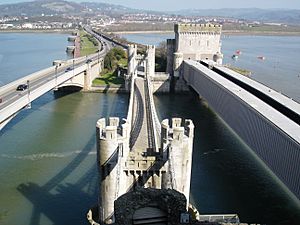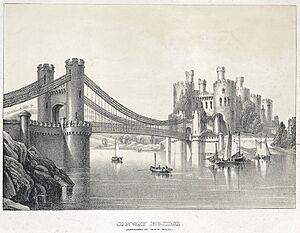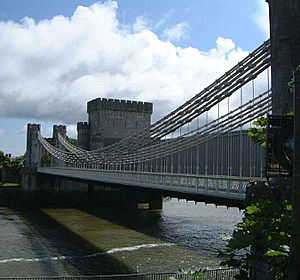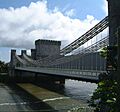Conwy Suspension Bridge facts for kids
Quick facts for kids Conwy Suspension Bridge |
|
|---|---|

The bridge as seen from Conwy Castle, with the modern road bridge to the left and the rail bridge to the right
|
|
| Carries | Pedestrians |
| Crosses | River Conwy |
| Locale | Conwy |
| History | |
| Constructed by | Thomas Telford |
| Construction begin | 1822 |
| Construction end | 1826 |
The Conwy Suspension Bridge is a very old and important bridge in North Wales. It was one of the first suspension bridges ever built for road traffic. Today, you can only walk across it. This historic bridge is located in the medieval town of Conwy, right next to the famous Conwy Castle. The National Trust now looks after it.
Contents
Building the Conwy Suspension Bridge
The famous engineer Thomas Telford designed and built the Conwy Suspension Bridge. Construction started in 1822 and finished in 1826. It cost about £51,000 to build, which was a lot of money back then! Before the bridge, people used a ferry to cross the River Conwy at this spot.
The bridge is about 99.5 meters (326 feet) long. It was built to look like the nearby Conwy Castle, which is a World Heritage Site. Telford also built another famous bridge, the Menai Suspension Bridge, which looks similar.
Changes Over Time
Over the years, the Conwy Suspension Bridge has been updated.
- In the late 1800s, the original wooden road surface was replaced with a stronger iron one.
- In 1903, extra wire cables were added above the original iron chains to make the bridge even stronger.
- A year later, in 1904, a 6-foot-wide walkway was added just for people walking.
The bridge was used for cars until December 13, 1958. A new, modern road bridge was built right next to it to handle more traffic. Since 1965, the National Trust has owned the old suspension bridge. Now, it is only used by people on foot, and there is a small fee to cross it.
How the Bridge Was Designed
Telford made sure the bridge blended in with Conwy Castle. The bridge deck hangs from four layers of chains. An extra layer was added later to make it even stronger. These chains go over tall towers that look like parts of a castle, with a central archway and decorative stone features.
On the east side of the river, the chains are held firmly by a large stone and concrete base. On the west side, the chains are anchored directly into the castle's walls and the solid rock beneath. Some parts of the castle even had to be removed during construction to make sure the cables were securely attached.
See also
 In Spanish: Puente colgante de Conwy para niños
In Spanish: Puente colgante de Conwy para niños
Images for kids






